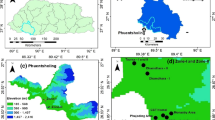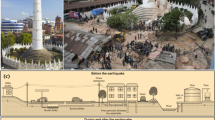Abstract
One of the developing areas in Bengkuku City, Indonesia is the downstream of Muara Bangkahulu River. Therefore, this study aims to present an investigation of the local site and analysis of ground response in this area. Geophysical measurements were adopted in this research using multichannel analysis of surface wave and microtremor. Furthermore, field measurements were processed to interpret the characteristics of the ground surface, such as shear wave velocity (Vs) profiles, time-averaged shear wave velocity for the first 30 m depth (Vs30), and site classifications. The results show that the study area is categorised into Site Classes C and D. Also, the loose sedimentary soils exist at shallow depth and tend to be more vulnerable to undergo seismic phenomenon, which includes liquefaction and ground amplification. Generally, the results are expected to provide a better understanding of geophysical characteristics and earthquakes, which will help the local government to compose a spatial plan on the basis of seismic hazard mitigation.















Similar content being viewed by others
References
Mase LZ (2018) Reliability study of spectral acceleration designs against earthquakes in Bengkulu City, Indonesia. Int J Technol 9(5):910–924. https://doi.org/10.14716/ijtech.v9i5.621
Mase LZ (2017) Liquefaction potential analysis along coastal area of Bengkulu Province due to the 2007 Mw 8.6 Bengkulu Earthquake. J Eng Technol Sci 49(6):721–736
Farid M, Mase LZ (2020) Implementation of seismic hazard mitigation on the basis of ground shear strain indicator for spatial plan of Bengkulu City, Indonesia. Int J Geom 18(69):199–207. https://doi.org/10.21660/2020.69.24759
Misliniyati R, Mase LZ, Syahbana AJ, Soebowo E (2018) Seismic hazard mitigation for Bengkulu Coastal area based on site class analysis. IOP Conf Ser Earth Environ Sci 212:1–11. https://doi.org/10.1088/1755-1315/212/1/012004
Puteri DM, Affandi AK, Sailah S, Hudayat N, Zawawi MK (2019) Analysis of peak ground acceleration (PGA) using the probabilistic seismic hazard analysis (PSHA) method for Bengkulu earthquake of 1900–2017 period. J Phys Conf Ser 1282(1):1–11. https://doi.org/10.1088/1742-6596/1282/1/012054
Kanlı AI, Tildy P, Prónay Z, Pınar A, Hermann L (2006) VS30 mapping and soil classification for seismic site effect evaluation in Dinar region, SW Turkey. Geophys J Int 165(1):223–235
Long M, Donohue S (2007) In situ shear wave velocity from multichannel analysis of surface waves (MASW) tests at eight Norwegian research sites. Can Geotech J 44(5):533–544. https://doi.org/10.1139/t07-013
Sitharam TG, Anbazhagan P (2008) Seismic microzonation: principles, practices and experiments. EJGE Spec Vol Bouquet 8:1–61
Chakrabortty P, Kumar U, Puri V (2018) Seismic site classification and liquefaction hazard assessment of Jaipur City, India. Indian Geotech J 48(4):768–779. https://doi.org/10.1007/s40098-017-0287-x
Mase LZ, Likitlersuang S, Tobita T, Chaiprakaikeow S, Soralump S (2020) Local site investigation of liquefied soils caused by Earthquake in Northern Thailand. J Earthq Eng 24(7):1181–1204. https://doi.org/10.1080/13632469.2018.1469441
Koçkar MK, Akgün H (2012) Evaluation of the site effects of the Ankara basin, Turkey. Appl Geophys 83(1):120–134. https://doi.org/10.1016/j.jappgeo.2012.05.007
El-Hady S, Fergany EAA, Othman A, Mohamed GEA (2012) Seismic microzonation of Marsa Alam, Egypt using inversion HVSR of microtremor observations. J Seismolog 16(1):55–66. https://doi.org/10.1007/s10950-011-9249-4
National Earthquake Hazards Reduction Program (NEHRP) (1998) Recommended Provisions for Seismic Regulation for New Buildings and Other Structures: Part 1-Provisions and Part 2-Commentary. FEMA 302, Texas, USA
Hausler E, Anderson A (2007) Observation of the 12 and 13 September 2007 Earthquake, Sumatra, Indonesia. Build Change Report, Denver, Colorado, USA
Natural Disaster Agency of Bengkulu Province (BPBD) (2018) Geological map of Bengkulu City, Indonesia. Natural Disaster Agency of Bengkulu Province (BPBD), Bengkulu, Indonesia
Sadeghi SH, Gharemahmudli S, Kheirfam H, Darvishan AK, Harchegani MK, Saeidi P, Vafakhah M (2018) Effects of type, level and time of sand and gravel mining on particle size distributions of suspended sediment. Int Soil Water Conserv Res 6(2):184–193. https://doi.org/10.1016/j.iswcr.2018.01.005
Tsukamoto Y, Kawabe S, Kokusho T (2012) Soil liquefaction observed at the lower stream of Tonegawa river during the 2011 off the Pacific Coast of Tohoku Earthquake. Soils Found 52(5):987–999. https://doi.org/10.1016/j.sandf.2012.11.016
Putrie NS, Susiloningtyas D, Pratami M (2019) Distribution pattern of settlement in 2032 based on population density in Bengkulu City. IOP Conf Ser Earth Environ Sci 284(1):1–8. https://doi.org/10.1088/1755-1315/284/1/012007
Lachet C, Hatzfeld D, Bard PY, Theodulidis N, Papaioannon C, Savaidis A (1996) Site effect and microzonation in the City of Thessaloniki (Greece): comparison of different approaches. Bull Seismological Soc Am 86(1):1703–1962
Bard PY (2004) The SESAME-FP5 project: an overview and main results. In: Proceedings of the 13th world conference on earthquake engineering, 1–6 August, Vancouver, Canada
Kanai K, Tanaka T (1954) Measurement of the microtremor. Bull Earthq Res Inst 32(1):199–209
Nakamura Y (1989) A method for dynamic characteristics estimation of subsurface using microtremor on the ground surface. Railway Techn Res Inst Quart Rep 30(1):25–33
Atakan K (2009) The need for standardized approach for estimating the local site effects based on ambient noise recordings. In: Mucciarelli M, Herak M, Cassidy JF (eds) Proceedings of the NATO advanced research workshop on increasing seismic safety by combining engineering technologies and seismological data. The NATO science for peace and security series-C: environmental security, XVIII, Dubrovnik, Croatia, 19–21 September, pp 3–15
Lachet C, Bard PY (1994) Numerical and theoretical investigations on the possibilities and limitations of Nakamura’s technique. Phys Earth 42(1):377–397. https://doi.org/10.4294/jpe1952.42.377
Bonnefoy-Claudet S, Cornou C, Bard PY, Cotton F, Moczo P, Kristek J, Fah D (2006) H/V ratio: a tool for site effects evaluation, results from 1-D noise simulations. Geophys J Int 167(2):827–837. https://doi.org/10.1111/j.1365-246X.2006.03154.x
Raptakis DG, Manakou MV, Chávez-García FJ, Makra KA, Pitilakis KD (2005) 3D configuration of Mygdonian basin and preliminary estimate of its site response. Soil Dyn Earthq Eng 25(11):871–887. https://doi.org/10.1016/j.soildyn.2005.05.005
Park CB, Miller RD, Xia J (1999) Multichannel analysis of surface waves. Geophysics 64(3):800–808. https://doi.org/10.1190/1.1444590
Nazarian S, Stokoe II, Kenneth H, Hudson WR (1983) Use of spectral analysis of surface waves method for determination of moduli and thicknesses of pavement systems. Transp Res Rec 930:38–45
Eikmeier CN, Prado RL, Taioli F (2016) Combined use of active and passive surface waves for shallow subsurface investigation in noisy urban area of São Paulo City, Brazil. Braz J Geophys 34(1):13–24
Kausel E, Roesset JM (1981) Stiffness matrices for layered soils. Bull Seismological Soc Am 71(6):1743–1761
Abrahamson NA, Silva WJ, Kamai R (2014) Summary of the ASK14 ground motion relation for active crustal regions. Earthq Spectra 30(3):1025–1055. https://doi.org/10.1193/070913EQS198M
Boore DM, Stewart JP, Seyhan E, Atkinson GM (2014) NGA-West2 equations for predicting PGA, PGV, and 5% damped PSA for shallow crustal earthquakes. Earthq Spectra 30(3):1057–1085. https://doi.org/10.1193/070113EQS184M
Campbell KW, Bozorgnia Y (2014) NGA-West2 ground motion model for the average horizontal components of PGA, PGV, and 5% damped linear acceleration response spectra. Earthq Spectra 30(3):1087–1115. https://doi.org/10.1193/062913EQS175M
Chiou BSJ, Youngs RR (2014) Update of the Chiou and Youngs NGA model for the average horizontal component of peak ground motion and response spectra. Earthq Spectra 30(3):1117–1153. https://doi.org/10.1193/072813EQS219M
Idriss IM (2014) An NGA-West2 empirical model for estimating the horizontal spectral values generated by shallow crustal earthquakes. Earthq Spectra 30(3):1155–1177. https://doi.org/10.1193/070613EQS195M
Silva V, Crowley H, Varum H, Pinho R (2015) Seismic risk assessment for mainland Portugal. Bull Earthq Eng 13(2):429–457. https://doi.org/10.1007/s10518-014-9630-0
Thompson EM, Wald DJ (2012). Developing VS30 site‐condition maps by combining observations with geologic and topographic constraints. In: Proceedings of the 15th world conference on earthquake engineering, 24–28 September, Lisbon, Portugal
Cannon EC, Dutta U (2015) Evaluating topographically-derived Vs30 values for seismic site class characterization in Anchorage, Alaska, USA. In: Proceedings of the 6th international conference on earthquake geotechnical engineering, 2–4 November, Christchurch, New Zealand
McPherson A, Hall L (2013) Site classification for earthquake hazard and risk assessment in Australia. Bull Seismol Soc Am 103(2A):1085–1102. https://doi.org/10.1785/0120120142
Mase LZ, Likitlersuang S, Tobita T (2018) Analysis of seismic ground response caused during strong earthquake in Northern Thailand. Soil Dyn Earthq Eng 114(11):113–126. https://doi.org/10.1016/j.soildyn.2018.07.006
Wills CJ, Petersen M, Bryant WA, Reichle M, Saucedo GJ, Tan S, Treiman J (2000) A site-conditions map for California based on geology and shear-wave velocity. Bull Seismol Soc Am 90(6B):S187–S208. https://doi.org/10.1785/0120000503
Koçkar MK, Akgün H, Rathje EM (2008) Evaluation of site conditions for the Ankara Basin of Turkey based on seismic site characterization. In: Proceedings of the 14th world conference on earthquake engineering, 12–17 October, Beijing, China
Thitimakorn T, Channoo S (2012) Shear wave velocity of soils and NEHRP site classification map of Chiangrai city, Northern Thailand. Electron J Geotech Eng 17:2891–2904
Elgamal A, Yang Z, and Lu J (2006) Cyclic1D: a computer program for seismic ground response. Report No. SSRP-06/05, Department of Structural Engineering, University of California, San Diego, La Jolla, California, USA
Misliniyati R, Mase LZ, Irsyam M, Hendriawan H, Sahadewa A (2019) Seismic response validation of simulated soil models to vertical array record during a strong earthquake. J Eng Technol Sci 51(6):772–790. https://doi.org/10.5614%2Fj.eng.technol.sci.2019.51.6.3
Tönük G, Ansal A (2008) Effects of stress reduction factors on liquefaction analysis. In: Congress of geotechnical earthquake engineering and soil dynamics IV, 1–10, May 18-22, Sacramento, USA. https://doi.org/10.1061/40975(318)66
Pender MJ, Orense RP, Wotherspoon LM, Storie LB (2016) Effect of permeability on the cyclic generation and dissipation of pore pressures in saturated gravel layers. Geotechnique 66(4):313–322. https://doi.org/10.1680/jgeot.SIP.15.P.024
Vivek BS, Mohanty S (2016) 1D Ground Response Analysis of Bhubaneswar Soil in India. In: Proceedings of the 6th international conference on recent advances in geotechnical earthquake engineering and soil dynamics, August 1–6, 2016, Greater Noida, India
Likitlersuang S, Plengsiri P, Mase LZ, Tanapalungkorn W (2020) Influence of spatial variability of ground on seismic response analysis: a case study of Bangkok subsoils. Bull Eng Geol Environ 79(1):39–51. https://doi.org/10.1007/s10064-019-01560-9
Mase LZ (2017) Shaking table test of soil liquefaction in Southern Yogyakarta. Int J Technol 8(4):747–760. https://doi.org/10.14716/ijtech.v8i4.9488
Mase LZ, Likitlersuang S, Tobita T (2019) Cyclic behaviour and liquefaction resistance of Izumio sands in Osaka, Japan. Mar Georesour Geotechnol 37(7):765–774. https://doi.org/10.1080/1064119X.2018.1485793
Kramer SL (1996) Geotechnical earthquake engineering. Prentice Hall, New Jersey
SNI 03-1726-2012 (2012) Standard of earthquake resistance design for building. National Standardization Agency, Jakarta
Acknowledgement
This research was supported by the competitive Research Scheme from University of Bengkulu No. 2357/UN30.15/LT/2018. Authors would like to thank Soil Mechanics Laboratory and Geophysics Laboratory, University of Bengkulu for experiments and site investigation performed in this study.
Author information
Authors and Affiliations
Corresponding author
Additional information
Publisher's Note
Springer Nature remains neutral with regard to jurisdictional claims in published maps and institutional affiliations.
Rights and permissions
About this article
Cite this article
Mase, L.Z., Refrizon, Rosiana et al. Local Site Investigation and Ground Response Analysis on Downstream Area of Muara Bangkahulu River, Bengkulu City, Indonesia. Indian Geotech J 51, 952–966 (2021). https://doi.org/10.1007/s40098-020-00480-w
Received:
Accepted:
Published:
Issue Date:
DOI: https://doi.org/10.1007/s40098-020-00480-w




